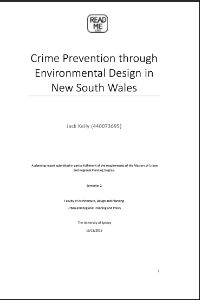By Jack Kelly
The aim of this research is to inform crime prevention and planning policy development by using an institutional perspective to understand why and how local governments in New South Wales have adopted Crime Prevention through Environmental Design (CPTED) principles into their local planning policies. By both reviewing the literature on the effectiveness of CPTED in reducing crime and the current crop of Development Control Plans (DCP) in New South Wales which have incorporated CPTED, the research will reveal that there is limited empirical evidence to support the assertion that CPTED reduces crime, and that local government needs to adopt a more integrated and contextual approach to embedding CPTED into their policies. From this perspective, the inclusion of CPTED principles in local planning is argued to be counterproductive to a more comprehensive and effective response and eventually results in additional time and cost to the decision. This is in the context that assessment decisions are now being made within tighter approval times. It will be argued that the planning system has a stog tede to adopt ookook o uik fies to poles ithout osideig the overall effectiveness of the philosophy.
The University of Sydney, 13/11/2015, 87p.





